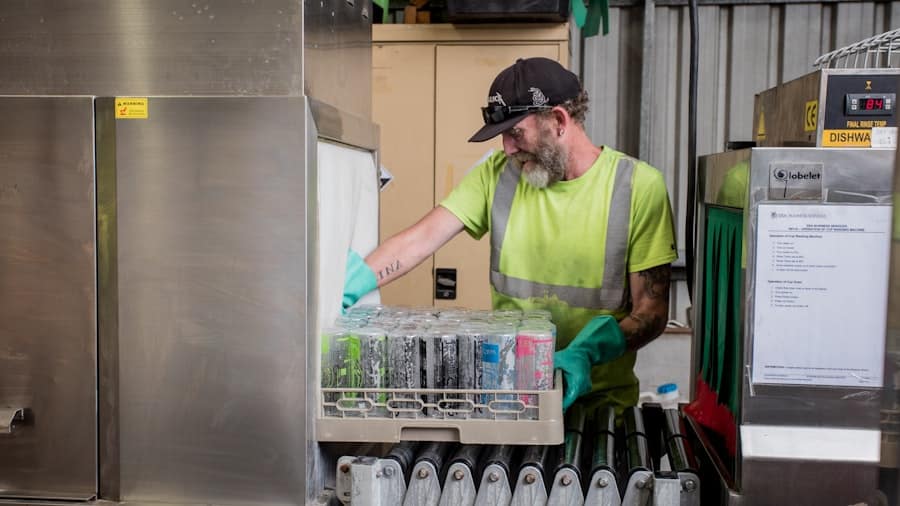The electronics industry has witnessed a significant transformation in recent years, with a growing emphasis on sustainable materials. This shift is largely driven by increasing consumer awareness regarding environmental issues and the urgent need to reduce the ecological footprint of electronic devices. Traditional materials such as plastics and metals, which often contribute to pollution and resource depletion, are being replaced or supplemented with more sustainable alternatives.
For instance, bioplastics derived from renewable resources like corn starch or sugarcane are gaining traction as viable substitutes for conventional plastics.
Moreover, companies are exploring the use of recycled materials in their products.
For example, Apple has made significant strides in incorporating recycled aluminum into its MacBook and iPhone designs. By utilizing recycled materials, manufacturers can significantly lower their carbon emissions and energy consumption associated with raw material extraction and processing. This trend is not limited to major corporations; smaller startups are also innovating with sustainable materials, such as using hemp fibers for casings or developing circuit boards from organic substrates.
The rise of sustainable materials in electronics is not merely a trend; it represents a fundamental shift towards a more responsible and circular economy.
Key Takeaways
- Sustainable materials are becoming increasingly popular in electronics, leading to a reduction in environmental impact.
- Energy-efficient design and innovation are driving the development of eco-friendly consumer electronics.
- Eco-friendly electronics are making a positive impact on reducing e-waste and promoting a circular economy.
- Renewable energy is playing a crucial role in powering consumer electronics, contributing to a more sustainable industry.
- Ethical and fair trade practices are gaining importance in electronics manufacturing, ensuring social and environmental responsibility.
Energy-Efficient Design and Innovation
Energy efficiency has become a cornerstone of modern electronics design, driven by both regulatory pressures and consumer demand for greener products. Innovations in energy-efficient technologies have led to the development of devices that consume significantly less power without compromising performance. For instance, advancements in semiconductor technology have enabled the creation of low-power processors that can perform complex tasks while drawing minimal energy.
This is particularly evident in mobile devices, where battery life is a critical factor for user satisfaction. Manufacturers are now focusing on optimizing power management systems to extend battery longevity, which not only enhances user experience but also reduces the frequency of battery replacements. In addition to hardware innovations, software plays a crucial role in energy-efficient design.
Operating systems and applications are increasingly being designed with energy consumption in mind. For example, many smartphones now feature adaptive brightness settings that adjust screen brightness based on ambient light conditions, thereby conserving battery life. Furthermore, machine learning algorithms are being employed to predict user behavior and optimize resource allocation accordingly.
This holistic approach to energy efficiency not only benefits consumers through lower energy bills but also contributes to a significant reduction in greenhouse gas emissions associated with electricity generation.
The Impact of Eco-Friendly Electronics on E-Waste

The proliferation of electronic devices has led to an alarming increase in electronic waste (e-waste), which poses severe environmental and health risks. However, the rise of eco-friendly electronics is beginning to mitigate some of these challenges. By designing products with sustainability in mind, manufacturers can reduce the volume of e-waste generated at the end of a product’s life cycle.
For instance, modular designs that allow for easy upgrades or repairs can extend the lifespan of devices, thereby reducing the frequency of disposal. Companies like Fairphone have pioneered this approach by creating smartphones that can be easily disassembled and repaired, promoting a culture of longevity rather than disposability. Moreover, eco-friendly electronics often incorporate recyclable materials that can be repurposed at the end of their life cycle.
This not only reduces the amount of waste sent to landfills but also conserves valuable resources by allowing materials to be reused in new products. The implementation of take-back programs by various manufacturers further supports this initiative by encouraging consumers to return their old devices for proper recycling. As awareness grows about the environmental impact of e-waste, consumers are increasingly seeking out eco-friendly options, prompting manufacturers to prioritize sustainability in their product offerings.
The Role of Renewable Energy in Powering Consumer Electronics
The integration of renewable energy sources into the consumer electronics sector is becoming increasingly vital as the world shifts towards sustainable practices. Solar power, wind energy, and other renewable sources are being harnessed to power electronic devices, reducing reliance on fossil fuels and decreasing carbon emissions. For example, solar-powered chargers and portable solar panels have gained popularity among outdoor enthusiasts and travelers who seek sustainable ways to keep their devices charged while minimizing their environmental impact.
These innovations not only provide convenience but also promote a greater awareness of renewable energy’s potential. Furthermore, manufacturers are beginning to incorporate renewable energy into their production processes. Companies like Tesla have made headlines for their commitment to using solar energy in their factories, significantly reducing their carbon footprint during manufacturing.
This trend is likely to expand as more companies recognize the long-term cost savings associated with renewable energy investments. By aligning their operations with sustainable energy sources, electronics manufacturers can not only enhance their brand image but also contribute to a more sustainable future for the industry as a whole.
The Importance of Ethical and Fair Trade Practices in Electronics Manufacturing
As the demand for eco-friendly electronics grows, so does the need for ethical and fair trade practices within the manufacturing sector.
For instance, the mining of conflict minerals such as tantalum, tin, tungsten, and gold has been linked to severe human rights violations in regions like the Democratic Republic of Congo.
To combat these issues, many companies are now prioritizing transparency in their supply chains and seeking certifications that ensure ethical sourcing. Fair trade practices not only promote social responsibility but also enhance brand loyalty among consumers who are increasingly concerned about the ethical implications of their purchases. Companies like Fairphone exemplify this commitment by ensuring that their supply chain is free from conflict minerals and that workers are paid fair wages under safe working conditions.
By adopting ethical practices, manufacturers can differentiate themselves in a crowded market while contributing positively to global social and environmental challenges.
The Shift Towards Repairable and Upgradable Electronics

The shift towards repairable and upgradable electronics represents a significant departure from the traditional model of planned obsolescence that has dominated the industry for decades. Consumers are becoming more aware of the environmental impact of disposable electronics and are demanding products that can be easily repaired or upgraded rather than discarded. This trend is evident in various sectors, including smartphones, laptops, and home appliances.
Companies like iFixit have emerged as champions of this movement by providing repair guides and parts for a wide range of devices, empowering consumers to take control of their electronics’ longevity. This shift not only benefits consumers but also aligns with broader sustainability goals by reducing waste and conserving resources. By designing products that can be easily disassembled and repaired, manufacturers can extend the lifespan of their devices and minimize e-waste generation.
Additionally, offering upgradeable components allows consumers to enhance their devices’ performance without needing to purchase entirely new products. This approach fosters a culture of sustainability and encourages manufacturers to prioritize durability and repairability in their designs.
The Integration of Biodegradable and Recyclable Components in Electronics
The integration of biodegradable and recyclable components into electronic devices is an innovative approach aimed at addressing the growing concerns surrounding e-waste and environmental sustainability. Biodegradable materials, such as those derived from natural sources like cornstarch or cellulose, offer an alternative to traditional plastics that persist in landfills for centuries. Companies are exploring ways to incorporate these materials into various components of electronic devices, including casings and circuit boards.
For instance, some startups are developing biodegradable phone cases that decompose over time without releasing harmful substances into the environment. Recyclable components also play a crucial role in reducing e-waste by ensuring that valuable materials can be recovered and reused at the end of a product’s life cycle. Manufacturers are increasingly designing products with recyclability in mind, using materials that can be easily separated and processed for reuse.
For example, many companies are adopting modular designs that allow for easy disassembly, making it simpler to recycle individual components rather than entire devices. This focus on biodegradable and recyclable materials not only helps mitigate environmental impact but also aligns with consumer preferences for sustainable products.
The Future of Eco-Friendly Consumer Electronics: Challenges and Opportunities
While the future of eco-friendly consumer electronics appears promising, it is not without its challenges. One significant hurdle is the need for widespread adoption of sustainable practices across the entire supply chain. Many manufacturers still rely on traditional materials and processes due to cost considerations or lack of awareness about sustainable alternatives.
Additionally, regulatory frameworks vary significantly across regions, making it difficult for companies to implement consistent sustainability practices globally. However, these challenges also present opportunities for innovation and growth within the industry. As consumer demand for eco-friendly products continues to rise, companies that prioritize sustainability will likely gain a competitive edge in the market.
Furthermore, advancements in technology may lead to new materials and processes that enhance sustainability while reducing costs. Collaborative efforts among stakeholders—including manufacturers, consumers, and policymakers—will be essential in driving this transition towards a more sustainable future for consumer electronics. In conclusion, while there are obstacles to overcome, the momentum towards eco-friendly consumer electronics is undeniable.
The integration of sustainable materials, energy-efficient designs, ethical manufacturing practices, and innovative recycling solutions will shape the future landscape of the industry. As awareness grows about environmental issues and consumer preferences shift towards sustainability, manufacturers must adapt to meet these demands or risk being left behind in an increasingly eco-conscious market.
In exploring the future of eco-friendly consumer electronics, it’s essential to consider the broader implications of sustainable practices across various industries. A related article that delves into innovative solutions in different sectors is What is BOPIS and How Does it Work?, which discusses the benefits of the Buy Online, Pick Up In Store (BOPIS) model. This approach not only enhances consumer convenience but also promotes sustainability by reducing carbon footprints associated with shipping and delivery.
FAQs
What are eco-friendly consumer electronics?
Eco-friendly consumer electronics are electronic devices that are designed and manufactured with a focus on minimizing their environmental impact. This can include using sustainable materials, reducing energy consumption, and implementing recycling programs.
Why is the future of eco-friendly consumer electronics important?
The future of eco-friendly consumer electronics is important because it addresses the growing concern for environmental sustainability. As electronic devices become more prevalent in our daily lives, it is crucial to minimize their impact on the environment through sustainable design and manufacturing practices.
What are some examples of eco-friendly consumer electronics?
Examples of eco-friendly consumer electronics include energy-efficient appliances, solar-powered devices, biodegradable packaging, and electronics made from recycled materials. Additionally, products with longer lifespans and easy repairability are also considered eco-friendly.
How can consumers contribute to the future of eco-friendly consumer electronics?
Consumers can contribute to the future of eco-friendly consumer electronics by choosing products with energy-efficient labels, recycling their old electronics, and supporting companies that prioritize sustainability in their manufacturing processes. Additionally, consumers can advocate for policies that promote eco-friendly practices in the electronics industry.
What are the challenges in the development of eco-friendly consumer electronics?
Challenges in the development of eco-friendly consumer electronics include the need for innovative sustainable materials, the reduction of electronic waste, and the implementation of efficient recycling programs. Additionally, balancing environmental considerations with technological advancements can be a challenge for manufacturers.

